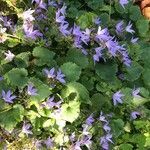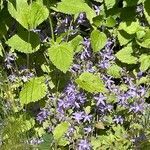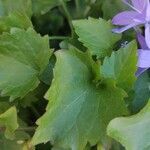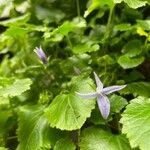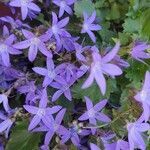Perennial, with numerous, long, trailing stems, often forming a loose mat. Basal lvs with petiole to c. 20 cm long. Lamina 3-6 × 2.5-5 cm, broad-ovate, almost glabrous, 2-serrate and ciliate; base cordate; uppermost lvs smaller, with short petioles. Fls declined, horizontal, or suberect, many in a ± secund, narrow, racemose infl.; pedicels to 20 mm long, glabrous or glabrate; bracts and bracteoles ciliate. Calyx 6-8 mm long; lobes narrow-lanceolate, ± purple, with 2-4, glandular, ciliate teeth. Corolla c. 1.5 cm long, very broadly funnelform; lobes deep, lanceolate-elliptic, soon reflexed, bluish mauve. Stigmas 3. Mature capsule not seen, turbinate.
More
A small plant. It keeps growing from year to year. It grows 15-20 cm high and spreads 45-60 cm wide. The stems are erect and grow in tufts. The leaves are narrowly oval and hairy. The flowers are lavender blue or violet. They are bell shaped and star shaped. They have 5 petals. They are in loose spikes at the top of the plant.
